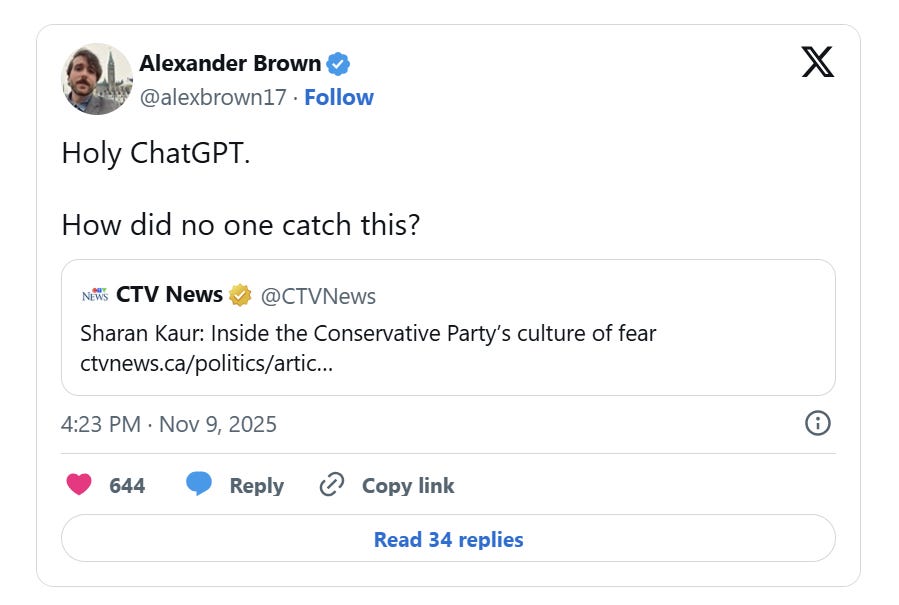Critics accuse CTV’s anti-Poilievre op-ed of being written by AI; author denies
A CTV News op-ed is raising eyebrows online after the author was accused of using artificial intelligence to write an article bashing Conservative leader Pierre Poilievre.
A CTV News op-ed is raising eyebrows online after the author was accused of using artificial intelligence to write an article bashing Conservative leader Pierre Poilievre.
The accusation surfaced Sunday evening on X after Juno News host Alexander Brown noticed suspicious grammar, syntax and rhetorical patterns in an article by CTV News journalist Sharan Kaur. The article was titled “Inside the Conservative Party’s culture of fear.”
Kaur has denied using AI to write the op-ed.
“Canadian politics has never been for the faint of heart. Every party has its fractures, leadership wars, and moments of chaos. But what’s happening inside the Conservative Party under Pierre Poilievre isn’t normal turbulence. It’s institutional decay disguised as discipline,” Kaur’s story begins.
As several X users noted, the structure and rhythm in Kaur’s opening and body paragraphs are strikingly similar to AI-generated text. They pointed to recurring transitional phrasing, overuse of em dashes, persistent employment of rhetorical devices like antithesis, symmetrical sentence lengths, incomplete syllogisms, and formulaic contrasts—all features commonly associated with AI generative writing tools.
The phrase, “this isn’t how you build a credible opposition. It’s how you run a cult,” is reminiscent of language typically employed by AI.
Furthermore, as noted by Brown and others, a well-known AI detector app used by university professors, editors and other writing professionals indicated “100% confidence” the article was written with the help of artificial intelligence.
Kaur has publicly denied the claim, calling her detractors “racist” in a Sunday X post.
“It’s never about substance,” Kaur wrote in an X post response to the allegations. “It’s my skin colour, how I look, where I’m from and now anyone with a brain who can write must be part of some grand plot.”
Kaur then used what appears to be another AI platform, Microsoft’s Gemini artificial intelligence software, to downplay the accuracy of the AI detection software referenced by Brown and others.
True North reached out to Kaur for comment, but did not receive a response prior to publication.
Meanwhile, both the regional and national phone numbers for CTV’s newsrooms went unanswered, with no option to leave a voicemail.
Bell Media, CTV’s parent company, was paid $5.3 million in taxpayer subsidies in its latest funding round from the Canadian Journalism Collective. The collective distributes over $100 million in annual funds to eligible media organizations based on government-imposed criteria.
At this stage, allegations that Kaur’s CTV News op-ed column may have been partially or wholly AI-written remain largely inconclusive.
The matter nonetheless raises compelling journalistic ethics questions about the use of the technology, especially when taxpayers fund journalistic organizations expected to produce original content.







Replacing “journalists” with AI would not only save CBC and the rest of MSM money but they could also increase the bonuses for those who are left to supervise and manage. Win Win for the management and the Liberal Party
Watch, CTV, GLOBAL and CBC soon to be replaced by AI. Reason, too costly to hire humans.